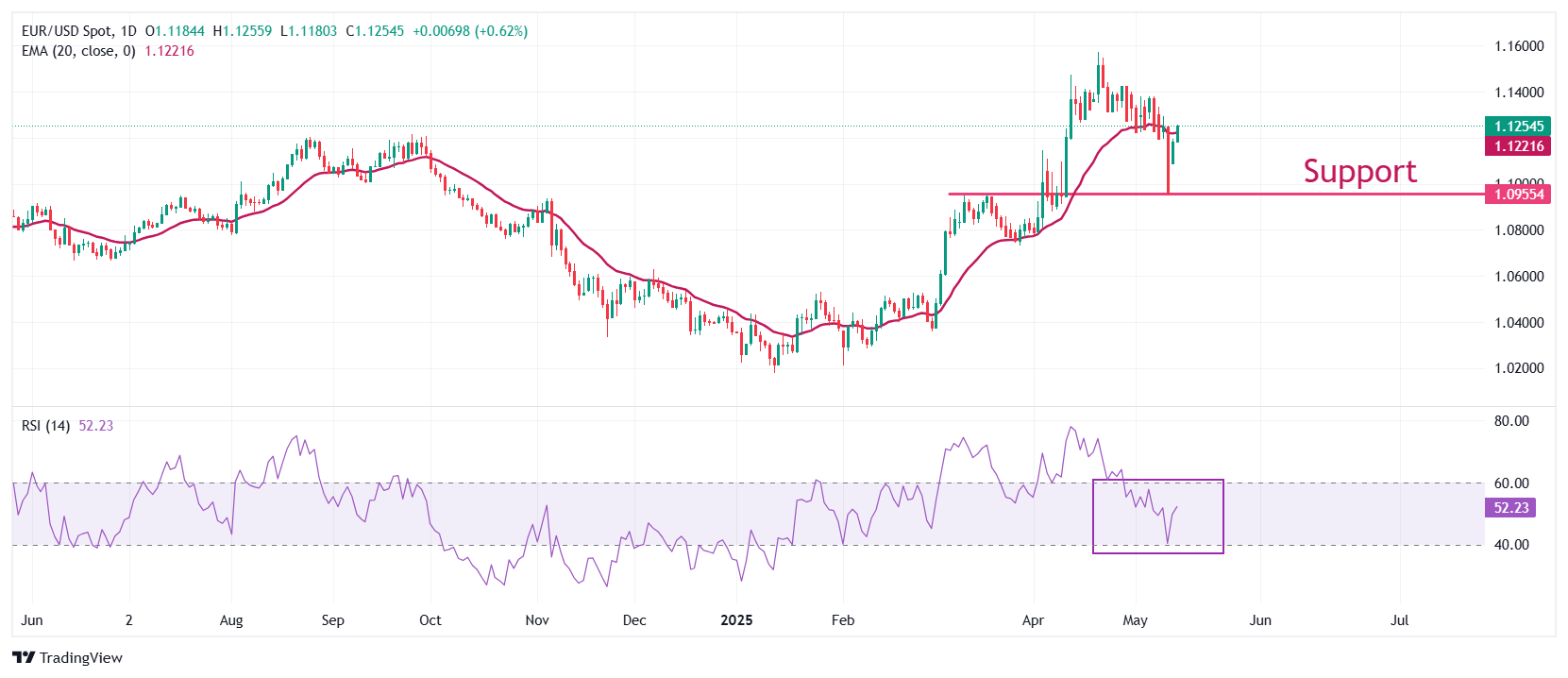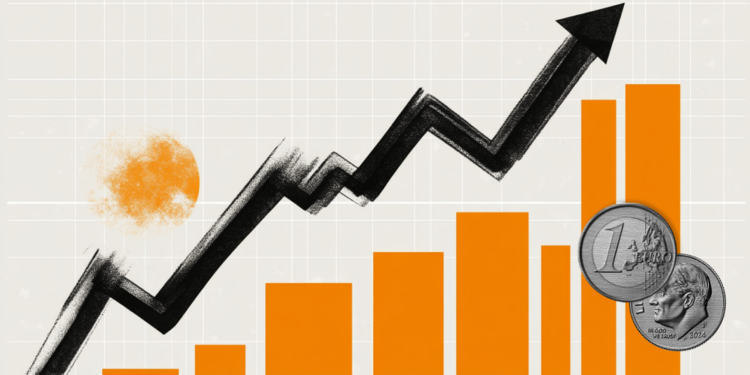- EUR/USD recovers further to near 1.1250 as the US Dollar suffers after the release of the soft US inflation data for April.
- US President Trump criticized Fed Powell again for not lowering interest rates.
- ECB Villeroy says he is hopeful of another interest-rate cut before the summer ends.
EUR/USD moves higher to near 1.1250 during European trading hours on Wednesday, extending Tuesday’s gains. The major currency pair has attracted significant bids at the expense of the US Dollar (USD), with the US Dollar Index (DXY) – which gauges the Greenback’s value against six major currencies – extending its retracement from the monthly high of 102.00 to around 100.50.
The Greenback suffers as United States (US) President Donald Trump criticized the Federal Reserve (Fed) again for not lowering interest rates after the release of the softer-than-expected Consumer Price Index (CPI) data for April on Tuesday. The data showed that the headline CPI rose by 2.3%, the lowest level in over four years.
“No Inflation, and Prices of Gasoline, Energy, Groceries, and practically everything else, are DOWN!!! THE FED must lower the RATE, like Europe and China have done,” Trump said in a post on Truth Social and added: “What is wrong with Too Late Powell? Not fair to America, which is ready to blossom? Just let it all happen, it will be a beautiful thing!”.
Despite slowing inflationary pressures and calls for interest rate cuts from US President Trump, traders have not pared bets supporting the Fed to cut borrowing rates before the September policy meeting. According to the CME FedWatch tool, the probability of the Fed keeping interest rates steady in the range of 4.25%-4.50% in July is marginally down to 63.3% from 65.1% seen on Tuesday.
It seems that an improvement in the US economic outlook due to the agreement with China for a temporary trade truce has absorbed the impact of cooling inflationary pressures. On Monday, the US and China agreed to avert a full-blown trade war and lowered tariffs by 115 percentage points.
US Dollar PRICE Today
The table below shows the percentage change of US Dollar (USD) against listed major currencies today. US Dollar was the strongest against the Australian Dollar.
| USD | EUR | GBP | JPY | CAD | AUD | NZD | CHF | |
|---|---|---|---|---|---|---|---|---|
| USD | -0.35% | -0.24% | -0.98% | -0.01% | -0.00% | -0.17% | -0.41% | |
| EUR | 0.35% | 0.11% | -0.67% | 0.33% | 0.34% | 0.16% | -0.06% | |
| GBP | 0.24% | -0.11% | -0.78% | 0.22% | 0.23% | 0.05% | -0.18% | |
| JPY | 0.98% | 0.67% | 0.78% | 0.98% | 1.00% | 0.81% | 0.58% | |
| CAD | 0.01% | -0.33% | -0.22% | -0.98% | 0.01% | -0.15% | -0.41% | |
| AUD | 0.00% | -0.34% | -0.23% | -1.00% | -0.01% | -0.16% | -0.40% | |
| NZD | 0.17% | -0.16% | -0.05% | -0.81% | 0.15% | 0.16% | -0.24% | |
| CHF | 0.41% | 0.06% | 0.18% | -0.58% | 0.41% | 0.40% | 0.24% |
The heat map shows percentage changes of major currencies against each other. The base currency is picked from the left column, while the quote currency is picked from the top row. For example, if you pick the US Dollar from the left column and move along the horizontal line to the Japanese Yen, the percentage change displayed in the box will represent USD (base)/JPY (quote).
Daily digest market movers: EUR/USD gains while investors ignore solid ECB dovish bets
- EUR/USD gains significantly due to a sharp correction in the US Dollar. The Euro (EUR) trades higher against its peers, except the Japanese Yen (JPY), on Wednesday. The major currency performs strongly even though European Central Bank (ECB) officials continue to stress the need to reduce interest rates further amid increasing confidence that US tariff policies will not increase Eurozone inflation. Theoretically, lower interest rates by the ECB bode poorly for the Euro.
- “We don’t see inflation picking up. The Trump administration’s protectionism will lead to a restart of inflation in the US, but not in Europe, which will likely allow for another rate cut by the summer,” ECB policymaker and Governor of the Bank of France Francois Villeroy de Galhau said, Reuters reported.
- Meanwhile, investors seek fresh cues on the progress of trade talks between the US and the European Union (EU). Investors have become anxious due to an absence of commentary from the White House about any progress in trade talks with the trading bloc, assuming sluggish efforts from the European Commission (EC) in resolving trade issues.
- This week, the major trigger for the shared currency pair will be the speech from Fed Chair Powell at the Thomas Laubach Research Conference in Washington on Thursday. Fed Powell is expected to provide fresh guidance on the monetary policy outlook in the wake of a temporary truce between the US and China.
- On the economic front, investors will focus on the Retail Sales and the Producer Price Index (PPI) data for April, which will be released on Thursday.
Technical Analysis: EUR/USD recovers to near 1.1250

EUR/USD extends its recovery to near 1.1250 on Wednesday. The pair bounces back strongly and recovers above the 20-day Exponential Moving Average (EMA), which trades around 1.1220, suggesting that the trend has turned bullish.
The 14-period Relative Strength Index (RSI) recovers strongly from 40.00, suggesting that bullish bias is intact.
Looking up, the April 28 high of 1.1425 will be the major resistance for the pair. Conversely, the March 11 high of 1.0950 will be a key support for the Euro bulls.
Economic Indicator
Consumer Price Index (YoY)
Inflationary or deflationary tendencies are measured by periodically summing the prices of a basket of representative goods and services and presenting the data as The Consumer Price Index (CPI). CPI data is compiled on a monthly basis and released by the US Department of Labor Statistics. The YoY reading compares the prices of goods in the reference month to the same month a year earlier.The CPI is a key indicator to measure inflation and changes in purchasing trends. Generally speaking, a high reading is seen as bullish for the US Dollar (USD), while a low reading is seen as bearish.
Read more.

